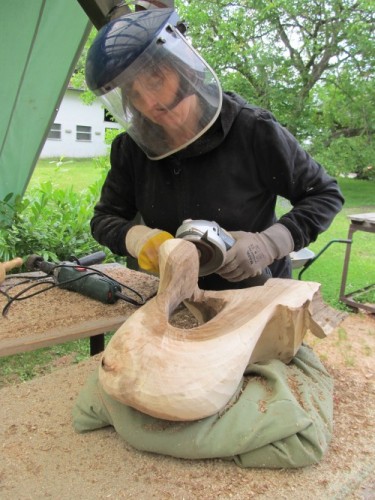
Zur Freilichtbühne 4
48268 Greven-Reckenfeld
Deutschland
Skulptour - Kreativ mit Holz
Maximum number of participants
We work in small groups of a maximum of six participants. During the workshops, I am available to guests with advice and action. I take care of your safety, explain the handling of the aids and always have a piece of chalk ready to make a design proposal. Where necessary and desired, I would be happy to help you practically.
registration reservation required
Due to the limited number of participants, prior registration / reservation is required. When assigning the places, the order of registration decides. If a workshop has to be canceled due to the insufficient number of participants ( less than three registrations ) or for other reasons, we will offer replacement dates. Interested parties who cannot switch to other dates will of course receive payments made without deduction.
For preparation
Every ( r ) participant should bring in
- Work gloves ( preferably two pairs )
- suitable Safety glasses
- suitable Respiratory protection ( at least one piece per half day )
- suitable Workwear
- stable shoes
Creative with wood
Treat yourself to a creative break. With a SkulpTour you can rediscover your creativity and create your own work of art. Dealing with unusual wood finds will sharpen your senses. You will see nature with different eyes, intensify your feeling for forms and re-understand things. A little courage and willingness to get involved is all it takes. SkulpTour will inspire you.
How we proceed
We follow the natural shapes of our workpieces, the nature of the wood and our spontaneous inspirations. We do not use recipes and building instructions.
It is best to just start without knowing where and how it will end. If you manage to put yourself in a childlike-playful mode, the best results will be achieved. As long as the process remains open and is not aimed at a specific goal, new and surprising ideas arise again and again. This opens up the space for creative people.
So we start
If we chose a blank, brought it to the workshop and roughly cleaned it, we can start.
First, the surface is freed from everything that cannot be saved. There are usually rotten or rotten spots and if there is still bark, this is usually removed. A lot of material is often removed. We do this with the high pressure cleaner, chainsaw, ax, hammer and chisel or goat iron - depending on what and how much can be done.
The first plan
Now it's time to develop ideas. What could it be? A vessel, a sculpture, a figure, maybe an animal or something very abstract. And where are the top and bottom, back and front? Should the object stand, lie or hang?
The answers to these questions are usually only preliminary. It is rare to stick to what you lay down in the first approach. As a rule, the idea mutates considerably in the course of the work. It can take a long time to know where you want to go. There are sometimes surprising new perspectives on an advanced level of processing. The wood shows its peculiarities. And machines and tools also want to "shape" occasionally".

On the go
Sometimes there is perplexity. It can help to resign, to look at the object from a distance and from different perspectives and to let it work. Sometimes it helps to come up with a title. The views and interpretations of the other participants can also inspire and help.

Our tools
In the course of the work, we use a wide variety of machines and tools.
The chainsaw is only helpful for rough work. We usually only need these at the beginning and not for very long.
There is also an almost unmanageable arsenal of larger and smaller machines and tools.

Which ( s ) is used when results in individual cases. Your personal preferences also play a role. You use what is best in your hand. And it can hardly be done without a good portion of manual labor.
For security
Isn't that too dangerous - chainsaw and angle grinder in lay hands?
No. The "beasts" are not without, but you can protect yourself appropriately. The best thing is to be aware of the risks and dangers. This is the best way to meet them.
You will receive a general one before starting work Security briefing.
On site, I will explain the appropriate handling of the devices and show you how to prevent injuries and accidents.
Of course, if necessary, we also use suitable protective agents: clothing, safety shoes, gloves, safety glasses, visor, hearing protection, respiratory protection, etc. And there is also an instruction on this. And of course all these protective agents are available here.
